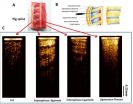(Press-News.org) This news release is available in French.
New research presented today by Dr. Jonathan Britt, from McGill University, helps to better understand how reward signals, such as those produced by addictive drugs, travel through the brain and modify brain circuits. Dr. Britt obtained these results using optogenetics, which use light-responsive proteins to study the activation of neural circuits in distinct locations, allowing the researcher to precisely dissect the roles of different neural circuits in the brain. Dr. Britt's studies have helped reveal circuits that are responsible for habitual behavior, which could be suitable targets for pharmacotherapies designed to treat drug addiction. These results were presented at the 2014 Canadian Neuroscience Meeting, the annual meeting of the Canadian Association for Neuroscience - Association Canadienne des Neurosciences (CAN-ACN) which takes place May 25 - 28th 2014.
One of the most immediate effects of drugs on the brain is an increase in the levels of dopamine, particularly in a region of the brain called the nucleus accumbens. Located near the center of the brain, the nucleus accumbens is connected, by intermingled populations of cells, to many other brain structures having roles in pleasure seeking and drug addiction. The nucleus accumbens is recognized as an integration centre for signals coming from many different brain regions, but the precise role of the different connections, and the means of their integration, resulting in specific behaviours, was until recently impossible to dissect. The advent of optogenetics has made it possible to study the various inputs that come from different regions of the brain, and their positive or negative effects on reward seeking, and their role in drug response in mice and rats.
Dr. Britt has characterized some of the ways that the nucleus accumbens integrates dopamine dependent reinforcement signals with environmental stimuli, which depend on a second neurochemical called glutamate. Glutamate-dependent signals to the nucleus accumbens come from many other brain regions, such as the hippocampus, the amygdala, the thalamus and the prefrontal cortex. Understanding how these different brain regions are interconnected will deepen our understanding of motivation, desire, pleasure seeking and addiction. This research is also applicable to the understanding of conditions such as Tourette's syndrome and obsessive-compulsive disorder.
"Goal-directed behaviour is regulated by large collection of interconnected brain regions. It is important to understanding how these component parts interact with each other in order to devise treatment strategies for psychiatric diseases such as addiction, Tourette's syndrome and obsessive-compulsive disorder," concludes Dr. Britt.
INFORMATION:
This research is funded by a grant from the Natural Sciences and Engineering Research Council of Canada (RGPIN-2014-05069).
About the Canadian Association for Neuroscience:
The Canadian Association for Neuroscience is the largest association dedicated to the promotion of all fields of neuroscience research in Canada. The association has been organizing a yearly annual meeting since 2007. Learn more about our meeting at: http://www.can-acn.org/meeting2014
Investigating the pleasure centers of the brain: How reward signals are transmitted
Research could help devise treatment strategies for psychiatric diseases such as addiction, Tourette's syndrome and obsessive-compulsive disorder
2014-05-27
ELSE PRESS RELEASES FROM THIS DATE:
Making the right choices in changing circumstances: Cognitive flexibility in the brain
2014-05-27
This news release is available in French. Choosing what is best is not always simple. Should one choose a small, certain reward, or take risks and try to get a larger reward? New research by Stan Floresco, from the Brain Research Centre at the University of British Columbia sheds light on the brain circuits that interact to help us decide the best strategy to adopt in changing circumstances. These results were presented at the 8th annual Canadian Neuroscience Meeting, taking place May 25-28 2014 in Montreal, Canada.
The studies of Dr. Floresco and his team used ...
Scientists develop new hybrid energy transfer system
2014-05-27
Scientists from the University of Southampton, in collaboration with the Universities of Sheffield and Crete, have developed a new hybrid energy transfer system, which mimics the processes responsible for photosynthesis.
From photosynthesis to respiration, the processes of light absorption and its transfer into energy represent elementary and essential reactions that occur in any biological living system.
This energy transfer is known as Forster Resonance Energy Transfer (FRET), a radiationless transmission of energy that occurs on the nanometer scale from a donor molecule ...
Google Glass adaptation opens the universe to deaf students
2014-05-27
Ordinarily, deaf students are left in the dark when they visit a planetarium.
With the lights off, they can't see the ASL interpreter who narrates their tour of outer space. With the lights on, they can't see the constellations of stars projected overhead.
That's why a group at Brigham Young University launched the "Signglasses" project. Professor Mike Jones and his students have developed a system to project the sign language narration onto several types of glasses – including Google Glass.
The project is personal for Tyler Foulger and a few other student researchers ...
May 27 update on Slide Fire, Arizona
2014-05-27
The winds have shifted and the Slide Fire smoke that once hung heavy and gray over Flagstaff is now covering the city of Sedona in Arizona. Over 20,000 acres have burned in the Coconino Forest in Arizona. Inciweb.org reports that during Memorial Day crews completed the final perimeter burnout around the fire. This perimeter created by the fire crews is approximately 40 miles of line to form a containment perimeter around the fire. The fire is considered 35 percent contained at this point.
Today (Tuesday May 27) crews will work on holding the containment line along ...
Agricultural fires light up central Africa
2014-05-27
It is currently the dry season in the Democratic Republic of the Congo and the Moderate Resolution Imaging Spectroradiometer (MODIS) on NASA's Aqua satellite captured this image on May 24, 2014. MODIS detected hundreds of active fires (location marked in red) in the Democratic Republic of the Congo and northeastern Angola, a sign that the agricultural burning season is underway.
Agriculture is responsible for more than half of the products produced by the Democratic Republic of the Congo, and fire is a central feature in agriculture across most of Africa. Places where ...
UCI researchers identify new functional roles on cell surfaces for estrogen
2014-05-27
Irvine, Calif., May 27, 2014 — A discovery by UC Irvine endocrinologists about the importance of cell surface receptors for estrogen has the potential to change how researchers view the hormone's role in normal organ development and function.
To date, scientists in the field focused on receptors in the cell's nucleus as the primary site for estrogen's effect on gene activity and organ development and function. There has been acknowledgement of similar estrogen receptors outside of the nucleus but much debate as to whether they are important.
To investigate this, Dr. ...
New method discovered to protect against chemical weapons
2014-05-27
CORVALLIS, Ore. – Researchers at Oregon State University have discovered that some compounds called polyoxoniobates can degrade and decontaminate nerve agents such as the deadly sarin gas, and have other characteristics that may make them ideal for protective suits, masks or other clothing.
The use of polyoxoniobates for this purpose had never before been demonstrated, scientists said, and the discovery could have important implications for both military and civilian protection. A United Nations report last year concluded that sarin gas was used in the conflict in Syria.
The ...
Moving 'natural capital' from metaphor to reality
2014-05-27
Economists have long touted the importance of quantifying nature's value — from the natural treatment of pollution by wetlands to the carbon storage capacity of forests — and including it in measures of national wealth.
But so far, achieving an actual measurable value for this "natural capital" has remained elusive, says Eli Fenichel, an assistant professor of bioeconomics and ecosystems management at the Yale School of Forestry & Environmental Studies.
In a new paper, Fenichel and co-author Joshua Abbott of Arizona State University report developing an approach to ...
Eastern Pacific season off with a bang: Amanda is first major hurricane
2014-05-27
The first tropical cyclone of the Eastern Pacific hurricane season grew into a major hurricane as Hurricane Amanda reached Category 4 status on the Saffir-Simpson scale over the Memorial Day holiday weekend. NASA and NOAA satellites watched as Amanda developed an eye while strengthening.
Fortunately, Amanda is far enough away from coastal Mexico that no watches or warnings are in effect today, May 27.
On Sunday, May 25, Amanda strengthened into the first Major Hurricane in the Eastern Pacific Ocean. Maximum sustained winds were near 155 mph (250 kph). Amanda was centered ...
Precision-guided epidurals and better blood monitors
2014-05-27
WASHINGTON, May 27, 2014—The march of modern medicine is often driven by revolutions in medical imaging. When technology advances, doctors are better able to peer deeply into human tissues, and thus able to detect, diagnose and treat human diseases more effectively.
Now, researchers have taken an established imaging technology called "optical coherence tomography," or OCT, and integrated it with other instruments to bring about the next revolution in imaging by helping doctors provide safer, less painful and more effective care for women in labor and people with diabetic ...
LAST 30 PRESS RELEASES:
UN University Report challenges climate change as sole trigger of Syrian Civil War, exposing governance failures in drought response
Real estate investment trust (REIT) acquisition associated with hospital closure and bankruptcy
New Raman imaging system detects subtle tumor signals
Boston Children’s receives a $7.5 million grant from Aligning Research to Impact Autism (ARIA) to provide clinical research coordination for the IMPACT Network
Spray-on antibacterial coating offers new protection for plants against disease and drought
ESMT Berlin study: What makes a first offer successful in negotiations
Groundbreaking ceremony marks the beginning of CTAO-South Array construction in Chile
Why swearing makes you stronger
What prevents more cancer patients from enrolling in potentially life-saving clinical trials?
UK’s worst-case climate risks laid bare for lawmakers
A decline in churchgoing linked to more deaths of despair
TAMEST announces Maralice Conacci-Sorrell, Ph.D., UT Southwestern Medical Center, as 2026 Mary Beth Maddox Award & Lectureship Recipient
Global study to evaluate whether dengue outbreaks can be anticipated earlier
Chonnam National University researchers propose innovative voltage-loop control for power factor correction
Accelerating next-generation drug discovery with click-based construction of PROTACs
Detecting the hidden magnetism of altermagnets
$7M gift supports health research, engineering and athletics at UT San Antonio
NU-9 halts Alzheimer’s disease in animal model before symptoms begin
Hospitals acquired by real estate investment trusts associated with greater risk of bankruptcy, closure
City of Hope scientists study rare disorder to uncover mechanism and hormone regulation underlying fatty liver disease and sweet aversion
Your genes may influence gut microbiome of others, rat study shows
‘Personality test’ shows how AI chatbots mimic human traits – and how they can be manipulated
Global food systems driving twin crises of obesity and global heating
Osaka Medical and Pharmaceutical University researchers capture real-time molecular movies of enzyme catalysis
Could your genes influence the gut microbiome of others?
Clues to Alzheimer’s disease may be hiding in our ‘junk’ DNA
Study reveals that the body uses different sensors to detect cold in the skin and in internal organs
iPS cells from dish to freezer and back
Deep neural networks enable accurate pricing of American options under stochastic volatility
Collective risk resonance in Chinese stock sectors uncovered through higher-order network analysis
[Press-News.org] Investigating the pleasure centers of the brain: How reward signals are transmittedResearch could help devise treatment strategies for psychiatric diseases such as addiction, Tourette's syndrome and obsessive-compulsive disorder







